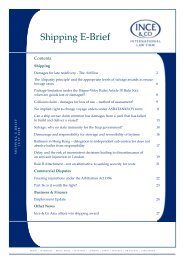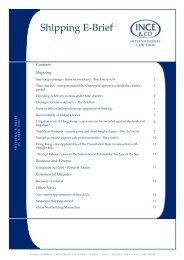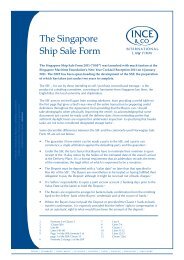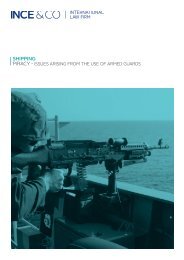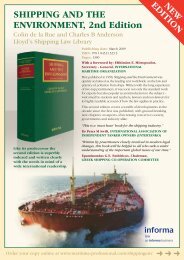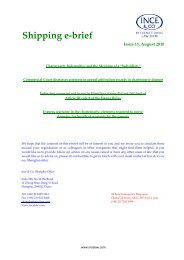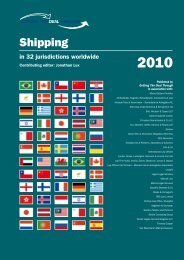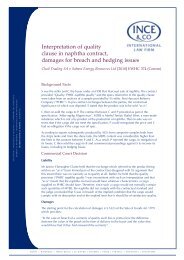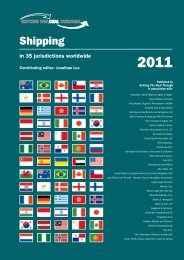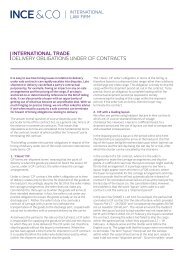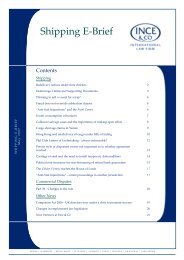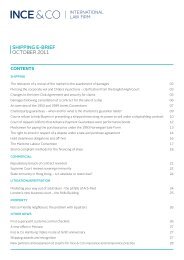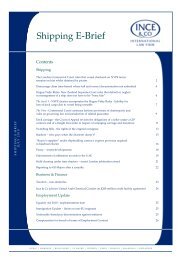Ince & Co aviation carbon trading newsletter
Ince & Co aviation carbon trading newsletter
Ince & Co aviation carbon trading newsletter
- No tags were found...
Create successful ePaper yourself
Turn your PDF publications into a flip-book with our unique Google optimized e-Paper software.
AVIATIONWhilst the <strong>aviation</strong> industry has defended GIACC’s approachas being modest and realistic, it has left an intellectualvacuum as regards <strong>aviation</strong>. If there are special reasons why<strong>aviation</strong> needs special measures, they need to be spelled outand agreed on quickly if <strong>aviation</strong> is not to be dealt withalong with the body of other <strong>carbon</strong> emitting activities. IATAis in practice leading the thinking for the <strong>aviation</strong> industry.We discuss their labours below.In advance of the <strong>Co</strong>penhagen summit, first world leadersare seeking to manage the expectations of their counterpartsin the developing world. Their message is that only apolitical consensus is likely to be reached in <strong>Co</strong>penhagen,with more work needed to turn consensus into a Treaty. Inthe meantime, the volume of editorial debate is increasing.Three themes seem to be emerging. It seems widelyexpected that the endgame will include all forms of <strong>carbon</strong>emission; there is increasing discussion of the idea of a ‘perperson’ cap on <strong>carbon</strong> emissions worldwide; and themechanism used will provide a universal price for <strong>carbon</strong>use. A global cap-and-trade system, allowing less developedcountries with spare ‘per person’ allowances to sell surplusallowances to those who want them, might be the result,though this approach would need measures to prevent givingincentives for population explosions.Proposals from the <strong>aviation</strong> industryGiovanni Bisignani, IATA’s Director General, has recentlypresented the <strong>aviation</strong> industry’s climate change strategy andtargets to ICAO and Ban Ki-Moon. IATA proposes a fourpillarstrategy based on technology, operations, infrastructureand economic incentives. They are committed to threetargets: improving fuel efficiency by an average of 1.5%annually to 2020; <strong>carbon</strong>-neutral growth from 2020; and a50% reduction of <strong>carbon</strong> emissions by 2050, compared to2005 levels. IATA sees the use of economic incentives as a‘bridging’ step until the full benefits of the other three pillarscan be realised.Not everyone in the industry agrees. The Air TransportAssociation of America (ATAA) believes that the fuel pricesalready provide incentives to minimise emissions, a positionthat seems to ignore the longstanding failure to price futureenvironmental damage into current fuel prices. In contrast,the Association of European Airlines (AEA) advocates marketbased measures in conjunction with the other three pillars.IATA predicts a 2% reduction in <strong>aviation</strong>’s <strong>carbon</strong> footprintthis year as a direct result of the four-pillar strategy, thoughthe economic downturn may flatter the figures. Bisignanisays that governments must also play their part. He claimsthat implementing more efficient air traffic 2 managementwould save about 6.5% of <strong>aviation</strong> CO emissions annually.Unfortunately, governments currently have little incentive tomake ATM more efficient. More controversially, Bisignaniclaims that fuel from biomass could reduce <strong>aviation</strong>’s <strong>carbon</strong>footprint by up to 80%.The industry is, however, united on a global sectoralapproach to reduce <strong>aviation</strong> emissions. This involves threemain elements: that <strong>aviation</strong>’s <strong>carbon</strong> emissions areaccounted for at a global level, not by states; that <strong>aviation</strong>should be fully accountable for its <strong>carbon</strong> emissions andrequired to pay only once for these emissions; and that theindustry has access to global <strong>carbon</strong> markets to offsetemissions.A global solution for <strong>aviation</strong> emissions is likely to have tobalance the principle of non-discrimination betweenoperators with a wish to allow differentiated responsibilitiesbetween countries at different stages of development.The AEA proposal tackles this wish. The AEA suggests thatcountries are grouped into three blocs according to theirmaturity, each with different targets. Air carriers operatingbetween two different blocs will be subject to the lowertarget. AEA favours a global, open cap-and-trade system formature markets (Bloc A) with <strong>aviation</strong> companies <strong>trading</strong>allowances with other industry sectors. GIACC is warm tothe approach but believes that ICAO lacks authority toimplement it.The Aviation Global Deal (AGD) Group, comprising leadinginternational airlines, <strong>aviation</strong> sector companies and TheClimate Group of general commercial companies, arguesthat all airlines should participate in an emissions <strong>trading</strong>scheme which is fully linked to the global <strong>carbon</strong> market.Individual airlines would be allocated allowances throughauctioning and free allocation. Revenue generated from theauctioning of allowances would be distributed throughrelevant expert international bodies or funds to supportclimate change initiatives in developing countries.Implementing the EU Carbon TradingScheme for airlinesAs with all Directives, 2008/101/EC (the “Directive”) requiresimplementation by Member States. They are now putting intoplace the new laws required to make the EU EmissionsTrading Scheme (ETS) apply to aircraft operators. Below weexamine their implementation in the United Kingdom, butthe same principles apply across the whole EU.With the assistance of Eurocontrol, all aircraft operators thatcarry out ‘<strong>aviation</strong> activities’, have now been assigned to aMember State, following principles set out by the<strong>Co</strong>mmission. This list will be updated periodically.The first of two tranches of implementation (RegulationNo.2301/2009) came into force in the UK on 17 September2009. This sets out requirements 2 for UK operators to submitMonitoring Plans for CO emissions and tonne-kilometredata for 2010. The regulator for England and Wales is theEnvironment Agency; for Scotland, the Scottish EnvironmentProtection Agency; and for Northern Ireland, the NorthernIreland Environment Agency.The second tranche is expected by February 2010, which isthe date by which all Member States must have implementedthe Directive.WWW.INCELAW.COM
Requirements for aircraft operatorsUK operators must have applied to their regulator for anEmissions Plan by 12 November 2009. The plan will outlinehow the operator will measure its CO emissions and cover2many practical issues such as emissions sources, fuelconsumption, assessment of uncertainties of measurementand a data flow diagram. Those wishing to apply for freeallowances must also apply for a Benchmarking Plan by 31December 2009 to set baseline emissions data.Both applications must be accompanied by, amongst otherthings, a proposed Monitoring Plan and a fee. There is asystem of penalties for failure to comply.Assuming all is in order, the regulator will issue anEmissions Plan. From 1 January 2010, the operator mustfollow it in monitoring its <strong>aviation</strong> emissions. The resultsmust be reported in an annual emissions report, which mustbe verified by an independent verifier by 31 March in thefollowing year. Failure means exposure to more penalties.There is a similar procedure for Benchmarking Plans. Verifiedbenchmark data is expected to be submitted to the <strong>Co</strong>mmissionby 30 June 2011, following which the <strong>Co</strong>mmission will publishits tonne-kilometre benchmark by 30 September 2011.Allocation of allowances for each operator will then bepublished by national regulators by 31 December 2011.These requirements impose a significant burden on airlineoperators and it is expected that many operators will fail tocomply fully with their requirements by the appropriatedeadlines. Sources indicate that a substantial number of UKoperators have not yet contacted their regulator for informationon how to comply. Given that the deadline for applications forEmissions Plans was 12 November 2009, it is likely that manyoperators will be exposed to fines and failure to submit acompliant application could lead to loss of free allowances.Although the size of fines may not be a significant deterrent forlarger airlines, operators’ requirements under the Directive andUK Regulations are ongoing and fines will continue to beimposed. Operators that have not already done so should obtainadvice on how to design and put in place systems to satisfy therequirements in the most cost-effective manner.Carbon Trading and <strong>Co</strong>unterparty RisksChris Walsh and Fred Vroom, with thanks to Rosalinda Tam and Robin AcworthAlthough the EUA is an intangible – the right to emit one tonne of CO 2 – it is effectively a standardised commodity and hasbecome freely tradable. Since they represent value, parties to an EUA ‘trade’ are concerned with each other’s ability to perform itsside of the bargain.As in any principal-to-principal transaction (known as an ‘over-the-counter’ (OTC) transaction), the seller takes the risk that thebuyer will not pay the price, and the buyer takes the risk that the seller will not deliver the underlying object. Non-, or incomplete,performance may be due to many reasons attributable to either party: some deliberate, some not, some avoidable, some not. Theserisks are known as ‘counterparty risk’. By <strong>trading</strong> on an exchange, counterparty risks are typically reduced. Exchange transactionscan thus provide an attractive alternative to OTC transactions, and all the more so during troubled economic times.Exchanges typically have three layers: the Exchange itself; its Members; and outsiders who wish to buy or sell the commodity onthe exchange.The rules of exchanges typically require Members to satisfy often stringent financial requirements. These may include balance sheettests and requirements to put up cash collateral (such as initial deposits and margin calls) to the Exchange in respect of each trade.In addition, each Member typically agrees to make good a pre-agreed percentage of any insolvent Member’s unpaid account.All trade on an exchange is carried only between a Member and the Exchange itself. A typical trade between two Members willthus consist of two complementary contracts in which the two Members each contract with the Exchange. Outsiders (i.e. nonmembers)must contract with Members, who will in turn enter into a back-to-back trade, as principals, with the Exchange. A tradebetween two outsiders thus consists of four complementary contracts.Exchanges and Regulators typically monitor the financial strength of exchange members on a continuing basis, and Regulatorstypically monitor the exchanges themselves. Through legal mechanisms known as netting and mutuality, and by their ability tomatch trades, as well as by initial deposits, margin calls, insurance and members’ indemnities, exchanges are able to ensure thattheir solvency is protected in the case of the insolvency of one or more of its members.For an outsider, counterparty risk is reduced to little more than the risk of the insolvency of the Member with whom they contract.In contrast, an OTC transaction may not be regulated, and the parties to OTC transactions need to consider counterparty risk everytime they trade. Whilst this may be more attractive in the case of large, infrequent transactions between very substantial parties, itis usually a less attractive option.In summary: exchanges have traditionally provided buyers and sellers of commodities, financial derivatives and (more recently)EUAs with a means of reducing the counterparty risk inherent to OTC transactions by limiting that risk to that of insolvency of theexchange member or, where the party is a member of the exchange, to that of the exchange itself.Buyers and sellers of EUAs and CERs will find that exchanges <strong>trading</strong> those commodities will not only provide a market-place, butwill also – and perhaps more significantly – provide a reduced level of counterparty risk that is easier to monitor.WWW.INCELAW.COM
AVIATIONIf you have any questions about these issues, please contact:Chris Walsh<strong>Co</strong>nsultant, LondonPrior to joining <strong>Ince</strong> Chris was part of the core senior managementteam at Emirates Airlines for 15 years where he was involved inevery aspect of the airline's operations.He has been involved in some of the highest value aircraftfinancing and leasing packages in commercial <strong>aviation</strong>. Headvises on both ‘plain vanilla’ and structured, asset-backedfinancing and re-financing of aircraft, engines and relatedequipment and has acted for lessees, operators and borrowers. Hisexperience includes involvement in the handling and negotiationof term sheets, finance leases and the full range of aircraft financeoperative documentation.Email: chris.walsh@incelaw.comTel: +44 20 7481 0010Fred VroomPartner, ParisFred is a founding partner of <strong>Ince</strong> & <strong>Co</strong> Paris. He regularly advisesaircraft operators on wet and dry leases, corporate sale andpurchases and operational matters. He advises financiers onrepossession and manufacturers’ support devices, often within a‘credit enhancement’ logic. Fred recently advised a majorinternational tour operator in relation to its acquisition of morethan 60 new Airbus aircraft.Email: fred.vroom@incelaw.comTel: +33153769100Ben <strong>Co</strong>nwaySolicitor, LondonBen has over ten years experience as an <strong>aviation</strong> finance lawyerand specialises in advising airlines, lessors and banks on operatingleases as well as the purchase and finance of all types of aircraft.Earlier in his career, Ben undertook a secondment to VirginAtlantic Airways for six months.Email: ben.conway@incelaw.comTel: +44 20 7481 0010WWW.INCELAW.COM
<strong>Ince</strong> & <strong>Co</strong> is an international commercial law firm which practises in seven broad strands:AVIATION | BUSINESS & FINANCE | COMMERCIAL DISPUTES | ENERGY & OFFSHORE | INSURANCE & REINSURANCE | INTERNATIONAL TRADE | SHIPPINGDubaiHamburgHong KongLe HavreLondonParisPiraeusShanghaiSingaporeT:+971 4 3598982T:+49 40 38 0860T:+852 2877 3221T:+33 2 35 22 18 88T:+44 20 7481 0010T:+33 1 53 76 91 00T:+30 210 4292543T:+86 21 6157 1212T:+65 6538 6660F:+971 4 3590023F:+49 40 38 086100F:+852 2877 2633F:+33 2 35 22 18 80F:+44 20 7481 4968F:+33 1 53 76 91 26F:+30 210 4293318F:+86 21 6170 3922F:+65 6538 6122E: firstname.lastname@incelaw.com24 Hour International Emergency Response T +44 20 7283 6999The information and commentary herein do not and are not intended to amount to legal advice to any person on a specific matter. They are furnished for informationpurposes only and free of charge. Every reasonable effort is made to make them accurate and up to date but no responsibility for their accuracy or correctness, nor for anyconsequences of reliance on them, is assumed by the firm. Readers are firmly advised to obtain specific legal advice about any matter affecting them and are welcome to speakto their usual contact.© 2011 <strong>Ince</strong> & <strong>Co</strong> International LLP, a limited liability partnership registered in England and Wales with number OC361890. Registered office and principal place ofbusiness: International House, 1 St Katharine's Way, London, E1W 1AY.LEGAL ADVICE TO BUSINESSES GLOBALLY FOR OVER 140 YEARSWWW.INCELAW.COM



